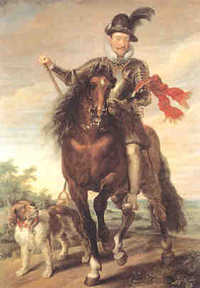
Battles and Campaigns
|
|
Swedish Wars 1600-1609 Livonia - Terrain of war operations During this period Livonia - known as Inflanty in Polish - was an important transit region for the Grand Duchy of Lithuania as well as the Duchy of Muscovy. The river Dzwina (Dvina) was of particular importance as a trade route for the White Ruthenian Lands. There were also land trade routes for Muscovy. Livonia was divided into:- The main town was Riga, a rich port, similar in many ways to its more westerly neighbour Gdansk. It was also the most important crossroad for overland routes. The countryside was comprised of large tracts of forests and wilderness and had a low population density. This gave significant supply problems for large forces, especially after the ravages of war.
At the end of the 16th century Livonia became a hotspot, triggered by the occupation of northern Estonia by Sweden. Poland had laid claim to these lands following the agreement made in 1561 with the Livonian Order of the Teutonic Knights. In 1588 Zygmunt Waza III (Sigismund Vasa) was elected King of the Polish Lithuanian Commonwealth. Part of his success was the desire that this would bring the two countries closer, end their conflicts and perhaps provide a much needed ally. Instead it was to lead to over a century of conflict and the eclipse of both countries by others. In 1594, after the death of the King John III of Sweden, his son, Sigismund became the rightful heir to the throne of Sweden. However his Catholic faith brought him a great deal of opposition from the mainly Lutheran Swedes, who were led by his uncle Charles Sundermanland. Sigismund attempted to break this opposition and in 1598 he landed with privately funded mercenary forces of Polish, German and Hungarian infantry. He did not have the support of the Sejm and fatally he failed to bring any Polish cavalry.
This did not end his hope of obtaining the Swedish crown and to gain Polish support he gave the Commonwealth the disputed territory of Northern Estonia, which was then in Swedish hands. On 12th March 1600 Zygmunt incorporated Estonia into the Commonwealth. |
Page 1
|
![]()
 Introduction
Introduction Cause
of the Polish Swedish conflict.
Cause
of the Polish Swedish conflict.  Sigismund
was not noted for his military skills, after some early successes
on the 4th November he was defeated at Jonkoping. He was forced
to come to terms with Charles and conceded to him in the Riksdag
(Parliament). He left Sweden, which in the next two years came under
the control of Charles and his supporters.
Sigismund
was not noted for his military skills, after some early successes
on the 4th November he was defeated at Jonkoping. He was forced
to come to terms with Charles and conceded to him in the Riksdag
(Parliament). He left Sweden, which in the next two years came under
the control of Charles and his supporters.